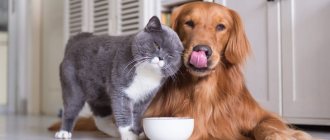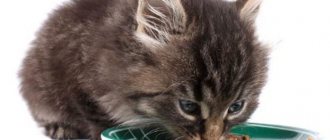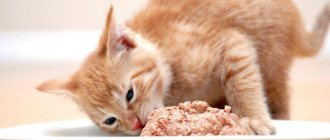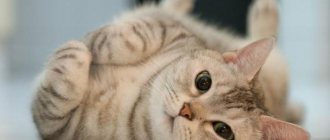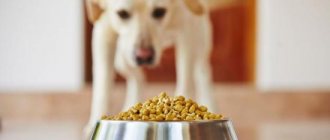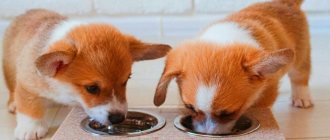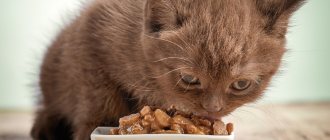July 9, 2018
Most owners believe that they can feed their cat dry and wet food at the same time, without thinking about the possible health problems that the animal may have due to such a diet. In this article we will try to cover in detail all the nuances associated with mixed feeding with ready-made food.
Wet food to add variety to your diet
Most supporters of mixed feeding argue their choice by the fact that their beloved animal gets tired of eating the same food every day. And so that the poor pet does not constantly chew “only crackers”, kind owners are ready to pamper him with all kinds of wet food, fortunately, pet stores offer a wide range of canned food: these are pates, mousses, pieces of fish or meat in jelly and sauce in various variations.
But is it really necessary for animals to have a varied diet? After all, representatives of the canine and feline orders, before their domestication, ate the same thing every day - the meat of one or two species of animals available in the territory of their residence. Since the meat diet did not contribute to the development of a large number of taste buds in predators, they, unlike humans, perceive food not by taste, but by smell, in which they primarily detect the presence of proteins of animal origin.
People often humanize their four-legged friends, believing that feeding them the same way seems boring to them. In fact, if we talk about diversity, it is necessary only in the sense that the diet must contain all groups of components necessary for the body of predators: meat as the main source of protein, and not only muscle, but also connective tissues, internal organs, and also animal fat and, in very small quantities, fiber.
In nature, predators obtain this variety by eating the prey almost entirely; the source of fiber and a small amount of carbohydrates is the remains of plant food in the stomach and intestines of the prey. Dry diets can provide all this variety to pets.
In one bowl or separately
There is no single recommendation on this matter from veterinarians and well-known manufacturers. Some believe that it is possible to mix different types of food in one bowl. Others insist that time should pass between the intake of dry and wet food. Since no research has been conducted on this issue, there is no clear answer.
Most recommendations highlight the following points:
- separation of food makes it possible to accurately track how much and what was given to the pet in terms of volume, composition, how much the animal eats, what can be mixed and what cannot;
- if you alternate food, it is easier to track the animal’s reaction to one or another type of food: what caused the allergy, indigestion and other undesirable effects;
- mixing feed leads to spoilage of the dish and loss of taste characteristics much faster.
Important! It is worth trying a mixed feeding option first, then separate feeding. You need to track which option was more preferable for the cat and make a choice in its favor.
Is wet food healthier?
As is the case with dry foods, wet diets can vary in composition and contain large amounts of beneficial meat ingredients or consist almost entirely of grains. The only fundamental difference between them is the moisture content.
Wet food is less concentrated in nutrients, as it consists of 80-90% water. Therefore, on the one hand, adding them to the diet can serve as an additional source of liquid, which is sometimes very important for cats, but on the other hand, to satiate and obtain all the necessary substances, wet food will need much more than dry food.
Wet food is not always complete
A much more important problem with mixed feeding is that it is much more difficult to achieve a balanced diet overall. Most dry food is complete, that is, containing all the necessary nutrients in the raw material (this is the best option) or thanks to special additives.
Wet food is often not a complete diet, for example, some tuna with shrimp or turkey with giblets are certainly healthy products, but feeding them to a cat or dog on an ongoing basis is unacceptable, because they may contain many useful substances, but completely missing others.
It is enough to give your pet dry food in the quantity recommended by the manufacturer, and you will fully cover your pet’s need for proteins, fats, carbohydrates, vitamins and minerals.
This must be taken into account when combining dry and wet diets, both in one bowl and at different feedings. Ideally, you should carefully study the composition of the wet food and choose a diet that is virtually identical to the dry food in most important respects.
It is quite difficult to do this, but otherwise you risk that the animal will not receive enough nutrients, while others will enter its body in excess, and thus an imbalance will arise that can lead to health problems. It is best to choose dry and wet food from the same manufacturer, so you can be sure that their composition is identical.
How to mix food correctly?
By adding any product to the dry diet, the owner rearranges the feeding pattern. If this scheme fits into the needs of the pet, then he can calmly accept this type of nutrition, but if not, this is fraught with a negative reaction from the body.
Therefore, you should not thoughtlessly introduce any canned food into your cat’s diet on an ongoing basis. If the owner gives one small bag or jar once a week and sees no changes in the animal’s appearance and digestion, then everything is fine. If your four-legged friend demands a delicious pate every day, then its introduction into the diet should be accompanied by a proportional reduction in the volume of dry food.
Simply adding an additional portion of food to the main diet is not worth it: this will only harm the animal’s health. All issues of feeding cats should be treated carefully, because this is the key to the long life of your four-legged friend.
When recalculating nutrients, it is necessary to evaluate the composition of the feed, see how many dry granules contain the same amount of proteins, fats and carbohydrates as a portion of canned food. This method is the most accurate. Although it seems difficult for many owners, in fact, the only thing that may be needed is a kitchen scale to determine the exact amount of daily food intake and perhaps a calculator to do the calculations.
If a package of wet food is divided into 2 or more parts during the day, then after opening it must be placed in the refrigerator. Also, you should not leave uneaten food in a bowl until the evening - unlike dry granules, which can sit for quite a long time without spoiling, bacteria that can cause food poisoning quickly begin to multiply in a wet product.
We suggest you read: What to feed your Pomeranian and how to care for it? Caring for puppies at home, nutrition and maintenance of dwarf Spitz dogs, reviews
Mixing different types of food is necessary for those pets who have weak immunity or who are not gaining weight. This diet is especially suitable for kittens at least six months old. With the help of dry food you can strengthen your jaws and teeth, while wet food will be a source of nutrients and will saturate the animal.
To properly combine feeds, you need to alternate them two or three times during the day. The number of meals depends on the age and each individual pet. Adults are fed twice a day, kittens and sick animals three or four times a day. You can choose one of two feeding options and always stick to it.
- First option. Alternate between dry and wet food two or three times a day depending on the cat. For example, an adult cat can be given wet food in the morning and dry food in the evening. If you have a kitten, give wet food morning and evening, and dry food day and night. In both cases, be sure to place a bowl of clean water nearby.
- Second option. One day – one type of food, the so-called one-day rule. For example, yesterday you gave your pet dry food, today you can offer him only wet food, and tomorrow, boil fish or prepare dairy products, then dry food again, and so on, in a circle, without disturbing the order.
If the animal refuses a particular type of food, be patient and a little persistent. For example, if you offer wet food in the morning and she refuses dry food in the evening, try offering dry food again the next morning.
Even when you mix different foods of the same manufacturer and of the same quality, you need to do this gradually, observing the animal’s well-being. If you see that he has a pale coat, lethargic behavior, dull eyes and any other signs, then it is better to stop combining food. These signs indicate that the animal’s body was unable to adapt to the innovation and it is better to return to its previous diet.
There is a myth that different types of food require the animal to produce different enzymes, and therefore you cannot change anything or mix them. But in reality this is not so - all cats (and predators in general) produce the same enzymes in the stomach and intestines. They will equally digest any food, no matter in what form it comes.
But otherwise, there are no obvious contraindications to mixing dry and wet food. The main thing is to do this wisely and carefully. It is better to adhere to the following rules:
- You can't leave food in a bowl all day. Many people pour in a large amount of granules, believing that the cat will eat them whenever he wants, and additionally add a whole jar of canned food, which gets airy and spoils during the day.
- It is worth deciding on the portion size in advance - the manufacturer's recommended daily volume of dry food is indicated on the packaging, and there you can also find recommendations on the proportions in which it can be mixed with canned food, if they are present in the same line of diets.
- If there are no such instructions, you should independently calculate the approximate daily nutritional value and think about how much dry food can be replaced with wet food.
How to calculate the feeding rate?
Another important issue is the amount of dry and wet food to comply with feeding standards. What should it be if, as we have already said, dry food is a much more concentrated product than wet food? It is, of course, possible to make a complex conversion to dry matter, but not everyone can cope with this task.
As a rule, owners divide the daily amount indicated on the packaging of dry and wet food in half, then, respectively, give dry food for half of the feedings and wet food for half. For example, dogs that eat twice a day usually receive 50% of the daily requirement of dry food in the morning, and 50% of the daily requirement of wet food in the evening.
Needless to say, any such calculation is very approximate, especially if the products are not identical in composition.
Is it possible to feed a cat only dry food?
On a high-quality option, selected taking into account gender, breed, age, lifestyle, and special needs, a cat can live a long life. The animal should have the opportunity to eat often, but little by little. This method is physiological for the animal. They can feed themselves up to 15-20 times per day.
Smell will be the cat's priority when choosing food; taste comes second. Animals' sense of smell is more developed than the sensitivity of their receptors.
Cats have well-developed associative memory. It is impossible to combine the introduction of a new food with a stressful moment. When moving, when a child or a new pet appears in the house, or during illness, food is left unchanged.
Dry food provides the necessary stress for predators on the jaw muscles and gums, removes plaque, and helps prevent diseases (allergies, urolithiasis). Only in some periods of life will drying have to be replaced with a wet option. For example, older animals and kittens find it difficult to chew pellets.
Can wet food be used as a treat?
Due to the high price of wet diets, many owners pamper their pets with them from time to time and wonder if it is possible to mix dry and wet food as an exception? Of course, a small portion of canned food will not cause any harm to the body, but only if you have chosen a good product with a complete composition.
Cheap jars and bags from the supermarket do not bode well for your pet. Of course, he will not be poisoned, however, due to the extreme poverty of their composition, such products often contain taste attractants, for example, hydrolysates - concentrated protein ingredients that make the smell of the food very rich and attractive to animals.
Many pets, especially cats, tend to be picky and may begin to refuse regular food and endlessly demand only tasty canned food. Owners often tend to follow their pet's lead, and as a result, animals receive poor-quality diets too often, sometimes instead of proper nutrition, which can negatively affect their health.
When do you need to change the type or diet of feeding?
When the food suits your pet and does not cause allergies, there is no need to change it. It happens that a cat refuses to eat for a day or two, this is normal if there are no signs of illness: vomiting, fever, diarrhea. This is how the animal cleans itself.
During this period, you can offer him a different diet option; perhaps pate or pieces in jelly instead of the usual dry food will stimulate his appetite. You can change the type of food during the rehabilitation period after an illness, when a cat is feeding kittens, injuries, diseases that prevent you from chewing hard lumps.
Pets that constantly consume soft food may suffer from tartar, periodontal disease, insufficient load on the chewing muscles; predators are supposed to chew and tear. It is still advisable to alternate between foods of different consistency. The food should be changed in case of hair loss, redness of the ears and other manifestations of intolerance or allergies.
Is it possible to change wet food?
Wet food needs to be chosen just as carefully as dry food, and the same rules apply. Carefully monitor the condition of your pet, and if a certain brand suits him, then you should not change it, although manufacturers are actively pushing for this by releasing products of the same brand with different tastes.
Any component of food can cause food allergies or intolerances, indigestion and other problems, so even if you use wet food as a treat, you should not strive for variety. If a cat or dog is cheerful, energetic, has shiny fur and regular bowel movements, and is neither losing weight nor gaining weight, then the diet is most likely chosen correctly and there is no need to change it.
Pros and cons of mixed cat nutrition
If you follow the above recommendations, monitor the daily calorie intake and buy high-quality food of high nutritional value for the animal, then mixed nutrition has no disadvantages.
On the contrary, cats love variety. You cannot use diets with a high content of plant components, fat, vegetables, corn derivatives, wheat: Kitikat, Friskas, Whiskas.
Many owners successfully use the method of feeding cats with wet and dry food. This type of food has no contraindications if the animal consumes both options with equal pleasure. Veterinarians believe that canned food is useful during hot periods, as it provides the body with moisture. You just need to monitor the norm and freshness of the contents of the bowl. Do you practice mixed feeding or do you prefer one type of food?
Time to keep food in bowl
For wet food, opened packaging should be kept in the refrigerator for no more than 2-3 days. In this case, the food should be transferred to a glass bowl.
It is advisable to store the opened food packaging in the refrigerator, hermetically sealed. Air access contributes to the oxidation of components and loss of their value.
Important! If wet food is in your cat's bowl, you should not leave it all day: it may spoil or dry out, especially if the room is hot.
The shelf life of dry food is usually indicated on the packaging. But it concerns exclusively the hermetically sealed version. However, an open pack of dry food can only be stored for 1.5-2 months. The fact is that the fats in the food are oxidized, which can cause gastrointestinal upset in the pet.
It is better not to leave food in a bowl for a long time
